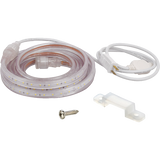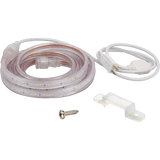Why Are LED Drivers Important for Strip Lighting?
Posted by Nick on for ProLampSales

You just returned from the hardware store with big dreams and an armload of LED strip lights. You open up all of the packages and -- what the heck? How do these things work? How do you turn them on?
Welcome to the World of LED Drivers
LED lights need a special device called an LED driver in order to turn on and operate. LED drivers perform a similar function to what a ballast does for fluorescent light bulbs. The driver processes line voltage into power suitable for the operation of an LED. In addition, because LED electrical properties change with temperature fluctuations, the driver regulates and maintains a constant amount of current.
What Do LED Drivers Do?
LED drivers serve three main purposes:- Most households use 120-277V AC electricity, but LEDs operate on low voltage DC electricity. Thus, the driver changes the higher voltage AC current into the lower voltage DC current to match what the LED lights need to operate.
- The input voltage to the driver must be the same as the voltage required by the driver. If not, the voltage variation can cause flicker or flashing.
- A common approach to controlling the light output of LEDs is by pulse-width modulation. When LED bulbs are dimmed, particular at the low end of light output, flicker may result.
Do LEDs Need a Driver?
Most LEDs require a driver, a few are designed to run on AC current. While the LED bulbs you screw into a fixture may not look like they have one, they actually have an internal driver just like screw-in CFLs have an integral ballast. Most household LEDs that are direct replacements for incandescent, halogen, and CFL bulbs with an E26/E27 or GU10/GU24 base have an internal driver.
It's the strip lights where people trip up. LED strips also require a driver, but you can buy strip lights separately from the driver, and one driver can supply electricity to multiple LED strips!
Is the LED Bad or Is It the Driver?
Here's another tip: if your LED lights are getting dim, it might be the driver that's the problem -- not the LED! Drivers operate at a high internal temperature, which is why LED life can be reduced if the bulb is in an enclosed fixture or used in a hot garage, for instance. The driver may fail before the solid state junction of the LED chip fails. This is also why LEDs are much better in cold temperatures than CFLs. They illuminate instantly (technically faster than incandescent) while comparable CFL bulbs may require a dim light, warm-up period before getting to full light output.
Finishing Up Those Strip Lights
So now, with your collection of LED light strips and no driver, what do you do? The only solution is to pick up a driver for your lights.
Featured Products (View All)
- 0 Comments
- Posted in LED
0 Comments




